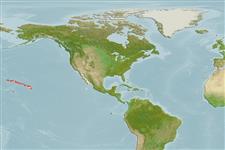Environment: milieu / climate zone / depth range / distribution range
Ecologia
marino associati a barriera corallina; distribuzione batimetrica 6 - 730 m (Ref. 58302). Tropical; 30°N - 15°N
Eastern Pacific: throughout the Hawaiian Islands, including the Leeward Group; rare in Johnston Island.
Size / Peso / Age
Maturity: Lm ? range ? - ? cm
Max length : 18.0 cm TL maschio/sesso non determinato; (Ref. 9710)
Spine dorsali (totale): 1; Raggi dorsali molli (totale): 36-39; Spine anali 0; Raggi anali molli: 32 - 36. Head and breast bluish gray, body yellowish or white. Head with irregular, oblique dark lines merging with many closely packed spots on body; region of mouth plus the lips white. Caudal fin red to orange, with a black sub terminal band; soft dorsal and anal fins clear to yellowish. Pelvic rudiment large narrowly attached to blackish posterior margin of ventral flap. Scale spinulation on midbody somewhat longer, finer and more acute than other species; each scale with high transverse ridge; male scale ridge rugosities develop at about 75 mm SL.
Inhabits coral reef areas (Ref. 9710). Benthopelagic over rock, rubble and sand; juveniles epi- and benthopelagic (Ref. 58302). Feeds on algae, small benthic invertebrates, and corals (Ref. 9710).
Life cycle and mating behavior
Maturità | Riproduzione | Deposizione | Uova | Fecundity | Larve
Hutchins, J.B., 1986. Review of the monacanthid fish genus Pervagor, with descriptions of two new species. Indo-Pac. Fish. (12):35 p. (Ref. 527)
IUCN Red List Status (Ref. 130435)
Threat to humans
Harmless
Human uses
Acquario: Commerciale
Informazioni ulteriori
Nomi ComuniSinonimiMetabolismoPredatoriEcotossicologiaRiproduzioneMaturitàDeposizioneSpawning aggregationFecundityUovaEgg development
Age/SizeAccrescimentoLength-weightLength-lengthLength-frequenciesMorfometriaMorfologiaLarveDinamica popolazioni larvaliReclutamentoAbbondanzaBRUVS
BibliografiaAcquacolturaProfilo di acquacolturaVarietàGeneticaElectrophoresesEreditarietàMalattieElaborazioneNutrientsMass conversion
Strumenti
Special reports
Download XML
Fonti Internet
Estimates based on models
Preferred temperature (Ref.
123201): 5.5 - 15.2, mean 8.7 °C (based on 7 cells).
Phylogenetic diversity index (Ref.
82804): PD
50 = 0.5039 [Uniqueness, from 0.5 = low to 2.0 = high].
Bayesian length-weight: a=0.01995 (0.00943 - 0.04220), b=2.93 (2.75 - 3.11), in cm total length, based on LWR estimates for this (Sub)family-body shape (Ref.
93245).
Trophic level (Ref.
69278): 2.8 ±0.0 se; based on diet studies.
Resilienza (Ref.
120179): Alto, tempo minimo di raddoppiamento della popolazione meno di 15 mesi (Preliminary K or Fecundity.).
Fishing Vulnerability (Ref.
59153): Low vulnerability (10 of 100).
Nutrients (Ref.
124155): Calcium = 52.8 [21.1, 135.2] mg/100g; Iron = 0.706 [0.330, 1.782] mg/100g; Protein = 17.8 [15.4, 20.0] %; Omega3 = 0.143 [0.064, 0.316] g/100g; Selenium = 55.7 [24.1, 133.2] μg/100g; VitaminA = 60.8 [14.4, 257.0] μg/100g; Zinc = 1.33 [0.82, 2.16] mg/100g (wet weight);
